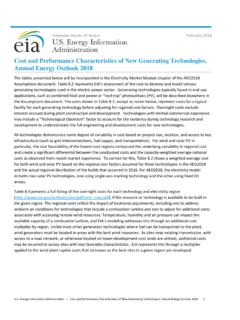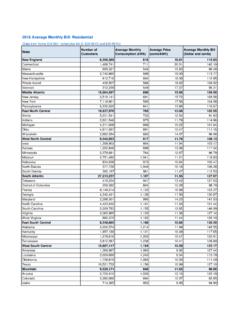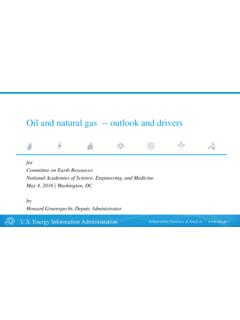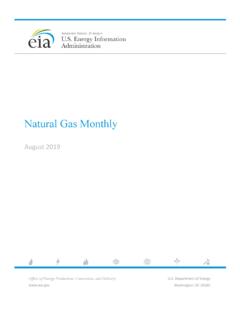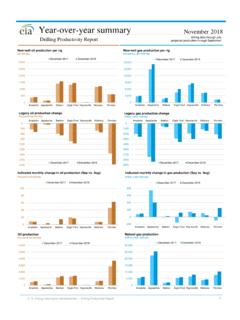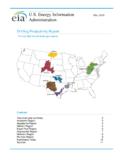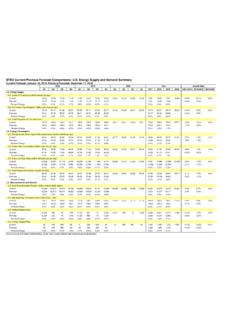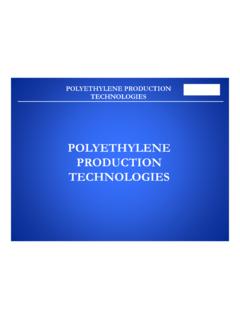Transcription of Country Analysis Executive Summary
1 1 Country Analysis Executive Summary : China Last Updated: September 30, 2020 Overview China is the world's most populous Country ( billion people in 2019) with a fast-growing economy that has led it to be the largest energy consumer and producer in the Rapidly increasing energy demand has made China influential in world energy markets. Despite structural changes to China s economy during the past few years, China s energy demand is expected to increase, and government policies support cleaner fuel use and energy efficiency measures. China s official data reported that its economy grew by in 2019, which was the lowest annual growth rate since 1990. After registering an average growth rate of 10% per year between 2000 and 2011, China s gross domestic product (GDP) growth has slowed or remained flat each year since The 2019 novel coronavirus disease (COVID-19) pandemic and resulting economic effects has adversely affected industrial and economic activity and energy use within China and are likely to push GDP growth much lower than 6% in 2020, according to numerous China is transitioning away from an economy that relies on growth in the manufacturing and export sectors to one that is more service oriented.
2 In 2018, the government attempted to e na ct financial regulatory reforms, reduce high local government debt levels, and cut air pollution levels from the industrial sector. However, the subsequent economic slowdown has put unemployment levels at risk of rising. The trade conflict with the United States, which began in 2017 and led to an increase in tariffs on most of China s goods exported to the United States, poses a downside risk to China s economic growth in the next few years. In the energy sector, the central government is moving toward more: o Market-based pricing schemes o Energy efficiency and anti-pollution measures o Competition among energy firms and greater market access for smaller, independent firms o Higher investments in more technically challenging upstream hydrocarbon areas such as shale gas and renewable energy projects 2 China has been seeking ways to attract more private investment in the energy sector by streamlining the project approval processes, implementing policies to improve energy transmission infrastructure to link supply and demand centers, and relaxing some price controls.
3 Coal supplied most (about 58%) of China s total energy consumption in 2019, down from 59% in 2018. The second-largest fuel source was petroleum and other liquids, accounting for 20% of the Country s total energy consumption in 2019. Although China has diversified its energy supplies and cleaner burning fuels have replaced some coal and oil use in recent years, hydroelectric sources (8%), natural gas (8%), nuclear power (2%), and other renewables (nearly 5%) accounted for relatively small but growing shares of China s energy The Chinese government intends to cap coal use to less than 58% of total primary energy consumption by 2020 in an effort to curtail heavy air pollution that has affected certain areas of the Country in recent years.
4 According to China s estimates, coal accounted for a little less than 58% in 2019, which places the government within its Natural gas, nuclear power, and renewable energy consumption have increased during the past few years to offset the drop in coal (Figure 1) 3 Pe trole um and othe r liquids Exploration and production Although China was the fifth-largest petroleum and other liquids producer in the world in 2019, most of the Country s production comes from legacy fields that require expensive enhanced oil recovery techniques to sustain production. After declining considerably for three years, China s petroleum and other liquids production reversed course and increased to million barrels per day (b/d) in 2019 (Figure 2).
5 Nearly 80% of the total liquids production was from crude oil, and the remainder was from conversions of coal and methanol to liquids, biofuels, and refinery processing gains. Oil production from coal-to-liquids (CTL) plants was an estimated 108,000 b/d and from methanol-to-liquids was around 500,000 b/d in China is attempting to monetize its vast coal reserves by converting some of it to cleaner-burning fuels and using them for bolstering energy security in the petroleum sector. At the end of 2016, Shenhua Group brought online the world s largest CTL plant, Ningxia, with a capacity to produce more than 80,000 b/d of China s CTL plant capacity could triple in size between 2017 and 2023, barring project Most of China s methanol is sourced from coal, and the government is encouraging more conversion of methanol to fuel and petrochemicals.
6 In response to China s growing use of imported crude oil, the government called for the national oil companies (NOCs) to raise domestic oil production levels in 2018. The oil price recovery starting in 2016 also made developing China s technically challenging fields profitable. These factors prompted the three major NOCs to increase joint upstream investment by 30% in 2018 and 23% in However, China s NOCs have indicated that they will reduce overall capital expenditures in 2020, but they have not provided details of their oil and natural gas production International oil prices were halved in March 2020, driven by severe contraction in fuel demand in response to efforts to prevent the spread of the COVID-19 pandemic and a significant increase in crude oil supply after production cuts were suspended by members of the Organization of the Petroleum Exporting Countries (OPEC) and partner countries.
7 Depressed oil prices pose a significant downside risk to the NOCs upstream investments and the Country s oil production levels in the next few years. Domestic crude oil production from many mature fields and technically challenging new developments, especially those involving onshore tight oil plays, is cost prohibitive at low oil prices and will likely decline during the next two To attract more investment and technical expertise and make China s upstream sector more competitive, the government plans to ease restrictions on foreign and private investment in China s conventional oil and natural gas upstream sectors starting in May 2020. Previously, foreign firms could not own a majority stake in a project and were required to be part of a joint venture with one of the NOCs to develop China s oil and natural gas fields.
8 Foreign firms and domestic independent companies that hold net assets of $43 million can participate in exploration and development of Chinese This initiative could boost crude oil production in more technically challenging fields in the longer term, although declines in mature basins will likely continue offsetting new production. Consumption China s oil consumption growth accounted for an estimated two-thirds of incremental global oil consumption in 2019. China consumed an estimated million b/d of petroleum and other liquids in 2019, up 500,000 b/d, or nearly 4%, from 201814 (Figure 2). 4 The warmer-than-normal 2019 20 winter in the northern hemisphere and ongoing efforts to prevent the spread of COVID-19 is expected to drastically lower China s growth in petroleum products, primarily jet fuel, gasoline, and diesel, with the most acute demand destruction occurring during the first quarter of 2020.
9 Diesel and gasoline accounted for the largest shares (27% and 24%, respectively, in 2018) of consumed oil products during the past several years. However, the pace of oil demand growth in the transportation sector has declined in the past few years because of China s economic slowdown, stricter environmental measures resulting in higher fuel efficiency standards and restrictions on urban vehicle use, and a higher penetration of alternative fuel vehicles (electric vehicles, compressed natural gas vehicles, and trucks and trains running on liquefied natural gas). Alternative fuel vehicles have grown exponentially in China and have displaced a growing amount of gasoline and diesel each However, the sale of vehicles that run on alternative fuels fell slightly in 2019 from 2018 following China s subsidy cut for these vehicles in July China, which has some of the most stringent global fuel standards, implemented national fuel standards equivalent to Euro VI to lower sulfur standards in gasoline and diesel starting in China s swiftly developing petrochemical sector is bolstering demand for liquefied petroleum gas (LPG) and naphtha.
10 Several propane dehydrogenation (PDH) plants are slated to come online through 2022 and will increase LPG demand. Several steam cracker projects are also under construction and require a combination of naphtha, LPG, and ethane for their fuel 5 Refining China has steadily expanded its oil refining capacity during the past decade to meet its strong demand growth and to process a wider range of crude oil types. China s installed crude oil refining capacity reached about 17 million b/d by the end of 2019 and ranks second behind the United States capacity The new capacity that began coming online in 2019 is from the first large integrated refinery complexes that are linked to petrochemical facilities.

